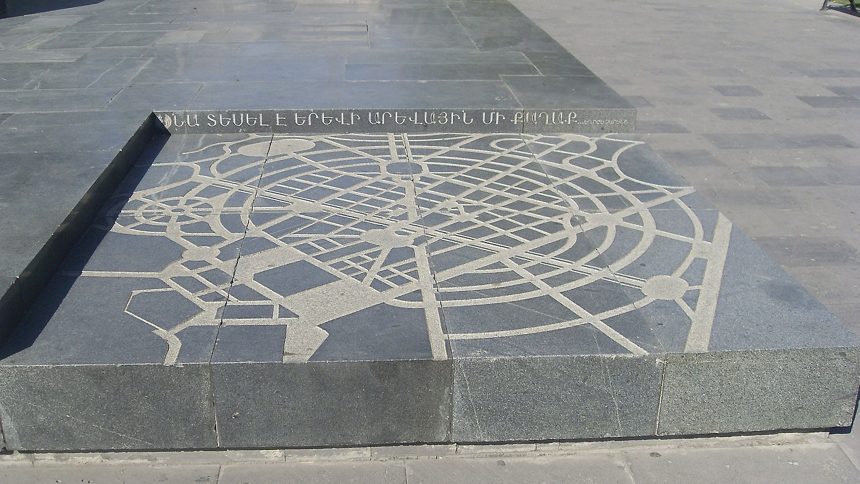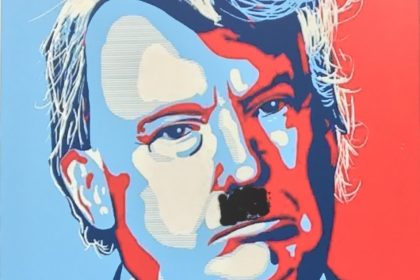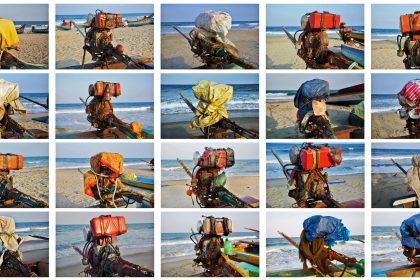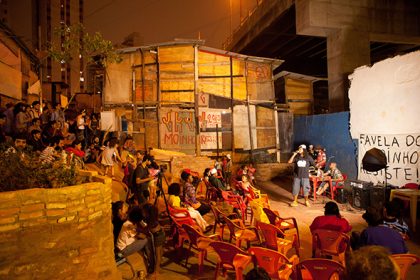Interview with Ruben Arevshatyan
Hande Sever
This interview with Yerevan-based artist, researcher, and independent curator Ruben Arevshatyan (b. 1965) explores the intricate intersections of architecture, politics, and culture in Armenia, focusing on the broader Soviet and post-Soviet contexts, as well as Ottoman and Russian imperialisms. Through a detailed discussion of early 20th-century Armenian urban development, Arevshatyan traces the ideological tensions that shaped architectural discourse—between historicism, socialist ideals, and modernist architectural visions. The interview sheds light on the ways in which Soviet modernism was both a tool for cultural creation and a site of contestation, especially when it came to nation-building and identity formation. Arevshatyan also addresses contemporary challenges in preserving modernist architecture, particularly in light of the current geopolitical climate, as seen after the Second Nagorno-Karabakh War and in the ongoing war in Ukraine. His reflections highlight the critical role architecture plays in shaping not just public and communal space but also the political and cultural identities of a nation. This conversation offers deep insights into the enduring legacies of Soviet modernism, the impact of wars on cultural heritage, and the ongoing struggle to protect public spaces in a world increasingly dominated by individualism and capitalist interests.
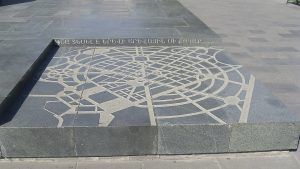
Hande Sever (HS): How did the political and economic transformations of early twentieth century Armenia shape the country’s urban development and public space, particularly in the capital city of Yerevan? For instance, in 1924, architect Alexander Tamanyan (1878-1936) developed a master plan (Fig. I) for Yerevan that was heavily influenced by the ‘garden city’ concept. How did this vision reflect the broader social and political changes of the time and its interaction with public space? Additionally, how did the Association of Proletarian Architects’ ideals interact with or challenge Tamanyan’s architectural and urban planning concepts?
Ruben Arevshatyan (RA): In Armenia, there’s a complex interplay between modernist visions—its political, economic, and socialist set-ups—and the transition to what we now define as postmodernism, or even beyond. Today, postmodernism feels somewhat outdated as we are once again witnessing new historical shifts, another spiral development of historical contexts. In this context, from my perspective, the most important questions revolve around convictions and beliefs—specifically, the belief in utopias and the possibilities of profound transformations which are achieved through extensive changes. For instance, in the early 20th century, Armenia not only regained its long-lost independence and statehood, but also embarked on a radical, revolutionary project to create an alternative social order, with entirely new social and economic structures. This transformation was envisioned as a collective endeavor. These transformations influenced not only Armenia’s social and economic development but also had a profound impact on its cultural thinking, shaped by these changes. However, it’s important to recognize that the modernist visions of building a new culture and society were highly heterogeneous. During this period, there were at least two or three distinct ideas about how society should be constructed. These competing ideas of nation-building and cultural creation were not only conceptualized but also materialized in architectural forms, literature, and visual artistic expressions. In 2014, as curators of the Armenian pavilion at the architectural biennial, I and my colleague Georg Schöllhammer focused on disclosing these conflicting modernist visions, which all aimed to build a new reality but with significant differences.[1]
In the architectural field, particularly with the principles introduced by Alexander Tamanyan—who is still regarded as the founder of Armenia’s new national architectural school—there were diverse conceptions. For example, for Yerevan, some of his ideas, besides the ‘garden city,’ were poetically compared to concepts like the ‘solar city,’ as described in Tommaso Campanella’s philosophical work, The City of the Sun. As a result, Tamanyan’s architectural vision was rooted in 19th-century European historicism, focusing on how to build a new nation-state and craft narratives that would unify and mobilize society under the name of the nation. He aimed to pinpoint moments of historical and cultural interruption to find the nucleus from which this new culture could be constructed. For Tamanyan, this was the medieval period, much like mid-19th-century European architects who sought inspiration in the Gothic or Romanesque periods to recreate their nation’s identity. In Armenia at the turn of the 20th century, his approach faced significant opposition. Some architects rejected the idea of reviving historical periods to build a new reality, instead favoring more revolutionary approaches.
This became a point of serious contention, as another group of architects, influenced by revolutionary contexts in Moscow, held different views. Architects such as Gevorg Kochar (1901-1973), Mikael Mazmanyan (1899-1971), Karo Halabyan (1897-1959), and Tiran Yerkanyan (1891-1963), after completing their education at VKhUTEMAS[2] in Moscow, returned to Armenia and formed what later became the Association of Proletarian Architects. Their vision for a new architecture and society was rooted in revolutionary ideals, where the proletariat was the central force, and social considerations shaped architectural forms. Criticizing Tamanyan’s approach of historicism they argued that it was impossible to create a ‘new national architecture’ by simply copying or referencing fragments of medieval architecture, which had entirely different social, historical, and economic contexts. Elements from religious buildings, for example, could not be repurposed for modern structures like a workers’ clubs without losing their original meaning. They contended that this approach tore medieval architectural elements from their cultural and historical roots, and when applied to new contexts, they could not form the basis of a truly national architecture. It is important to note that for newly formed republics and nations, the Soviet authorities sought to develop a new national policy. This policy found its expression primarily in cultural discourse, visual arts, and architecture, which became key tools for promoting and embodying these ideas. In this context, architecture and the arts were at the forefront of shaping and modeling the newly formulated national identity. Therefore, for these architects, the concept of the ‘new national’ was tied to the socialist policies of the newly formed Soviet republics. They were deeply engaged in researching how domestic spaces, such as living rooms, were organized and how new living environments could be recreated and improved for the working class—those outside the clergy and aristocracy—the exploited class. Therefore, they rejected the idea of reusing medieval forms in modern contexts, arguing instead for architecture that aligned with revolutionary ideals, rooted in the hegemony of the proletariat and using as an inspirational prototype the existing vernacular architecture for exploring the needs and spatial organization of the dwellings used by the once subjugated class. This debate highlighted the larger tension in Armenia’s architectural discourse: whether national identity could be forged by reviving historical elements or needed to be built from a revolutionary, socialist foundation. These dynamics sparked fascinating debates, especially throughout the 1920s and 1930s, as political discourses shifted and architectural principles transformed alongside changes in theoretical, literary, and political thinking.
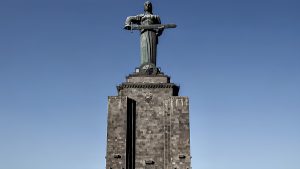
HS: That was truly illuminating, thank you. Next, I wanted to delve deeper into your insights on the complex interplay of ideology, culture, and architecture during and after the Stalinist era. In this context, could you elaborate on the key critiques of Soviet utopian ideals expressed by Armenian artists and architects of the time? Specifically, how did traumatic historical events, such as the Armenian Genocide, and their subsequent memorials and public monuments in Armenia, reflect broader ideological shifts and disillusionments and their manifestations in public space?
RA: The Stalinist policy dominated cultural and architectural discourse, reflecting the aesthetics of Stalin’s regime, which manifested both formally and politically. These processes created a new reality that radicalized artists and architects alike. However, this new context became a trap for many of these same artists and architects. The paradoxical nature of these ideological shifts—originally intended to create a new socialist society—often led to tragic outcomes. Some architects and artists, caught in the contradictions of Stalinist policy, were not only deprived of work but also exiled or imprisoned, with some meeting tragic fates. For example, during the Stalinist repressions, Kochar and Mazmanyan were exiled to Siberia and were only rehabilitated after Stalin’s death in 1955. These conflicts, particularly between competing visions of architecture and culture, were central to Soviet history.
By the second half of the 20th century, both globally and in the Soviet context, we witnessed the resurgence of modernist visions, driven by hopes and new utopias. Armenian cultural life, in particular, evolved significantly up until the 1960s, when there was a renewed focus on both universalist ideals and a revisiting of the past related to tragic episodes in the collective memory, such as the Armenian Genocide. These subjects, long taboo, began to surface as vital issues in cultural discourse. The repressions of the Stalinist era were also recontextualized, creating connections between the genocide and the injustices of the Stalinist regime. This connection to early 20th-century events led to efforts to reconsider and rebuild collective history, which in turn shaped collective identities. Cultural life became a key force in generating constructs of self-identification. By the mid-1960s, political processes in Armenia were deeply intertwined with cultural development, as Armenia navigated its dual identity as both a republic and a socialist nation. These dynamics created new tensions and problems that persist to this day. As the Soviet Union sought to develop national narratives for its republics, it simultaneously fragmented broader cultural identities. The political processes of the 1960s saw a shift from Stalinist control to a more horizontal, socialist system, leading to the revival of national identity. The removal of Stalinist symbols gave rise to new cultural icons, like the “Mothers of the Nation” monuments in various republics (Fig. II), which aimed to consolidate national identity. This shift allowed censored traumas to be revisited and addressed, fostering a new synergy in the creation of society.
For instance, such a shift can be seen in the emergence of the figure of the mothers. After Stalin’s death, the new political climate necessitated tighter control. In this context national narratives that developed at the grassroots level were used by central authorities to emphasize the distinct national identity of each republic, while simultaneously detaching them from the broader vision of building a unified state. This led to increasing fragmentation, with divergent political discourses emerging alongside one another. These parallel political agendas exerted a centrifugal force, pulling the republics further apart rather than uniting them under a common cause. So central powers used these narratives to emphasize the national identity of each Soviet republic while simultaneously detaching them from the broader vision of a united Soviet state. This led to increasing fragmentation, on one hand, there was a movement aimed at filling the gaps left by modernization, which involved censoring certain historical episodes and collective traumas, such as the Armenian Genocide—an issue echoed in other national contexts. So the Soviet ideological construct of “national in form, socialist in content” became the ideological framework that marked the end of the Soviet project. In this period, different cultural discourses gained momentum, symbolized by the substitution of key ideological figures such as monuments of Stalin was replaced with the symbolic “mothers” in countries such as Ukraine and Georgia alongside Armenia. So the statues representing ‘a father of a nation’ were replaced by mothers equal in size, consolidating new national identities both visually and culturally. These icons reemerged as unifying forces, reflecting how national policies, once censoring traumas, could be reinterpreted to build new synergies for creating a renewed sense of society. This shift illustrates how censored histories and traumas were reworked into national narratives that contributed to the evolving political and cultural landscape.
The major issue in the last two and a half decades of Soviet society was the development of these parallel ideologies within the framework of formal ideological constructs and political commissions. These ideologies, particularly within Soviet modernist thought, began to diverge from official doctrine and emerged through architecture, visual arts, and literature, often in direct confrontation with the state’s narratives. We even showcased this dynamic in an exhibition in Ukraine but unfortunately the war began…[3] The exhibition was raising critical questions about the Soviet modernist project, especially through architecture. It explored how parallel ideologies were generated from official cultural, aesthetic, and political visions, challenging the established narrative. During these times, artists and architects began to express their dissatisfaction with the Soviet project through critiques of utopian ideals, using dystopian and anti-utopian themes to question the disillusionment of the time. This tension highlighted the growing divide between revolutionary ideals and their material realization. Their core argument was that the ideas aimed at building a new society were often in direct opposition to the realities produced by these revolutionary ideals. As the gap between the initial vision and its materialization grew wider, the tension stemming from the growing divide between revolutionary ideals and their material realization reached a critical point.
One of the earliest examples of this contradiction was the Soviet abolition of the death penalty after the October Revolution, followed shortly by the onset of the Red Terror.[4] The grand industrialization projects of Stalinist modernization were implemented at great human cost, with millions suffering in the gulags. By the 1960s, these contradictions reached a peak, coinciding with global movements of disillusionments at varying circumstances. For example, in 1968, for me there was a significant moment of disillusionment tied to various events in Armenia. In 1965, the first student demonstrations demanding recognition of the Armenian Genocide took place, which served as a catalyst for the eventual construction of the memorial at Tsitsernakaberd (Fig. III). Later, another memorial was inaugurated to commemorate the Battle of Sardarapat, a crucial victory of the Armenian forces. This battle, a major achievement for the Dashnaks[5] and the Armenian people, marked a significant consolidation of their resistance against the Ottoman army in 1918. These events continue with significant setbacks for the new republic, which was on the brink of collapse, creating grounds for the disillusionment I mentioned earlier. However, these challenges provided a new impetus for statehood. Fifty years later, under Brezhnev, a monument was inaugurated to commemorate the First Republic. These moments reflected broader ideological shifts and opened up discussions that went beyond Soviet political goals to encompass the Armenian struggle for independence, revisited again in the 1990s with the First Nagorno-Karabakh war. These discussions continue today, as Armenia and other former Soviet republics reckon with the legacies of Soviet modernism, national identity, and political oppression. So the complex relationship between political, social, and cultural shifts over time created dramatic developments that shaped the trajectory of Armenia’s history and its public monuments.
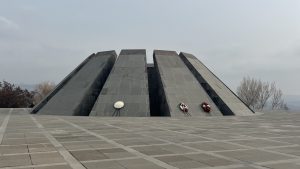
HS: By the mid-1980s, Soviet Armenia’s early engagement with Western contemporary art practices led to the dominance of postmodernist methodologies and styles, with avant-garde art particularly prominent. This new artistic wave, gaining substantial local momentum during this period, coincided with significant socio-political upheavals. For instance, during the glasnost period,[6] the 1988 Nagorno-Karabakh referendum sought to transfer the region to Soviet Armenia, citing self-determination laws in the Soviet constitution. This act triggered a series of pogroms against Armenians across Azerbaijan, eventually culminating in the First Nagorno-Karabakh war. In your essay “Between Illusion and Reality,” you argue that despite the chronological interconnectedness of these events, the artistic expressions of the 80s new wave ‘were largely devoid of explicit social relevance.’[7] Could you elaborate on the relationship between politics and the artistic expressions of this new wave? Additionally, how would you compare these artistic expressions to those emerging from Armenia now, in the aftermath of the Second Nagorno-Karabakh War?
RA: Interestingly, this text is connected to another piece I wrote called ‘Continuous Transitions’ in 2003, which was later published in 2005 in the Neighbors in Dialogue publication, curated by Beral Madra.[8] The project brought together a large number of artists from regions that were once part of the Ottoman Empire, and it was a very interesting collaboration. Notably, it was the first initiative where artists from Armenia participated in a project initiated in Turkey. Now, 20 years later, it’s interesting to reflect on that time. Considering the turbulent transformations we’ve gone through since then, it prompts a critical reexamination. The original text aimed to provide an objective overview of the institutional changes happening in the Armenian contemporary art scene between the 1980s and the early 2000s, while also describing the context that shaped and influenced these transformations.
The shift that occurred during the 1980s in Armenia was, in part, a cultural reaction to the specific identity clichés imposed by the political center in Moscow. This was a form of colonial, imperial attitude—one that sought to impose rigid identity constructs on culture, society, and the nation as a whole. In response, counter-movements emerged, but they often generated new identity clichés of their own, continuing the same discourse of imposing identities, albeit in different forms. What made the 1980s distinctive was the emergence of a new artistic movement that introduced a different aesthetic language and ideology—one that opposed not only the formal, ideologically driven imagery but also the political imagery of the so-called counter-movements, which was being displayed in institutions like the Modern Art Museum of Yerevan (MAMY). The real shift came with this new artistic movement, which distanced itself from both mainstream and counter-cultural political clichés.
When I described this period as being ‘devoid of the social,’ I didn’t mean a disengagement from reality, but rather a resistance to the dominant political order. Artists like Hamlet Hovsepian (b.1950), whom I highlight in the text, embodied this shift. His work rejected the grand, overbearing themes dictated by official ideology and instead focused on the most insignificant, everyday aspects of reality. Hovsepian’s performance Yawning (1975), for instance, where a man sits in front of a camera continuously yawning, is a prime example of this resistance. His work stripped away the monumental themes and narratives, emphasizing a more mundane and overlooked reality.
To compare this with someone like Sergei Parajanov (1924-1990), who while celebrated, still fit into the identity-focused narrative, whereas artists like Hovsepian rejected such narratives entirely, creating a new kind of aesthetic language. Parajanov’s work, though innovative, still fit within the larger framework of identity construction, whereas artists like Hovsepian, with his understated, almost absurd performances, symbolized a radical departure from these constructs. Comparing Parajanov to Hovsepian’s Yawning or other minimal gestures, like the woman in another video who simply ate her nails in front of the camera,[9] highlights the significant shift in focus. These artists embraced a misfit aesthetic, one that defied not only the official ideological discourse but also the counter-cultural art scene. This movement was about rejecting both the old and the ‘new’ identities imposed from above and instead finding expression in the overlooked and the insignificant.
HS: I understand that, for some of the artists in Soviet Armenia, there was a strong desire to move away from producing the kind of work that the central powers in Moscow wanted. At the same time, Moscow Conceptualism was also gaining prominence. For someone who may not be familiar with the political context of that period, some of the work by Moscow Conceptualists might also appear apolitical or detached from political causes. However, it’s clear that their work was a response to censorship and political pressures of the time. Do you think the artistic movements in Yerevan were similar in terms of resisting the political order?
RA: Of course! Another interesting aspect of Hamlet Hovsepian’s journey is that he left his village, Ashnak, for two years and went to Moscow. During that time, he became involved with the circles of Moscow Conceptualists.These artists rejected state-imposed aesthetic norms and sought alternative forms of expression. Hamlet was actively involved in this community, contributing to A-YA,[10] an important magazine that served as a platform for these artists, and participated in exhibitions that challenged the conventions of the time. Hamlet played an active role in these artistic communities. Despite his deep involvement and active participation in the Moscow art scene, after two years, he came to a personal revelation. He said, ‘Everything is clear to me now.’ I heard this story from the art critic Leonid Bazhanov (b. 1945), who recalled Hamlet saying, ‘Once I understood everything, I decided to return.’ So for Hamlet, the experience in Moscow was important, but once he felt he had fully understood the artistic and ideological landscape there, he chose to close that chapter and move on.
HS: I see, that’s a wonderful anecdote—thank you for sharing. It also made me think about the broader narratives around Moscow Conceptualism. For instance, when you look at art historical accounts about the movement, you rarely see mention of non-Russian artists or insight into how their networks functioned within the Soviet Union. Given that Hovsepian joined the art circles in Moscow and actively participated in the scene, would you say that when the history of Moscow Conceptualism was being written, artists who were not of Russian origin were left out of the narrative?
RA: I see your point and I agree, but it has a much more complex history. There was always a strong metropolitan attitude in Moscow, and only recently—especially with events like the war in Ukraine—has this been critically questioned. Even so, you can still trace elements of an arrogant, imperial discourse in the way these artists approached different ideas, particularly within conceptualism. This metropolitan attitude was prevalent, even if it wasn’t universal—there were, of course, brilliant and diverse artistic positions within those circles.
When we look at how the art scenes in Moscow and St. Petersburg related to each other, for example, there were already significant differences, and that’s without even discussing the peripheries or the republics. In the republics, artists were developing entirely different approaches, despite being influenced by the same overarching political contexts. The disillusionment was shared, but the political agendas varied greatly, which led to very distinct artistic developments.
This divergence in agendas and experiences means that the full scope of the story, especially when it comes to non-Russian artists like Hovsepian, is still under-explored. A deeper, comparative research effort is needed to fully understand these dynamics.
HS: I’d like to expand on the important point you just raised about the need for comparative research among the former Soviet states. Given the current situation in Ukraine and the growing reevaluation of Soviet and post-Soviet legacies, would you say there’s now an increased push or interest in conducting comparative research between these states? Specifically, is there a focus on understanding how their artistic, cultural, and political developments unfolded in parallel, yet under different circumstances and influences?
RA: At this moment, unfortunately, no, because we are still in the midst of intense and ongoing conflicts. As you know, the war in Ukraine didn’t emerge out of nowhere—it has a prehistory, and part of that prehistory includes the Second Nagorno-Karabakh War in 2020. I make this connection because, in the post-Soviet space, we’ve seen several conflicts before, such as the war in Georgia in 2008 and the occupation of Crimea. While these were very tragic episodes, they didn’t fully disrupt the lingering hope that these societies could eventually find a common ground for dialogue. After all, these countries once shared the largest nation-state, which, on one hand, aimed to build an alternative social order, but on the other, was focused on creating a new empire. This empire was built, and while we thought it had collapsed, its influence remains embedded in the collective thinking—not only in Moscow, but also in the former Soviet republics. It’s a kind of anathema that still exists.
Some readers might challenge this and ask, ‘How is that possible?’ But it is. Being part of that empire has left its mark on the collective mentality of these now separate nation-states, with varying degrees of imperial attitudes still present. It’s not surprising, then, that the former Soviet republics have displayed different reactions to the war in Ukraine, depending on their individual political contexts.
The concept of the ‘post-Soviet’ era began to unravel with the Second Nagorno-Karabakh War and collapsed entirely after the war in Ukraine. The Second Nagorno-Karabakh War served as a test for how a long-standing conflict could be accepted and normalized on a global scale—and it was. All of a sudden, it became clear that war could be tolerated as a new normal, rather than resolved through diplomacy. This normalization of war is perhaps the most tragic part of the situation.
These wars have fundamentally disrupted the post-Soviet discourse as we once knew it. Over time, there will likely be a renewed focus on modernist pasts, universalist ideals, and utopian visions for creating new social relationships. But to move forward, it will require a deep, critical approach—one that involves re-examining history, particularly through the lens of art, architecture, cinema, and culture. This will demand a new critical perspective.
HS: Thank you, Ruben. You’re right; once again witnessing the impact of wars across regions is a painful reminder of how interconnected history, culture, art, and architecture are with conflicts. The recent erasure of Armenian heritage in Artsakh is particularly troubling and highlights the urgent need to protect cultural heritage under threat. . .
In this light and given your extensive background in modernist architecture, I’d like to ask how attitudes toward preserving Soviet modernist architecture shifted after the Second Nagorno-Karabakh War and the war in Ukraine. During my last visit to Yerevan, you pointed out the Moscow Cinema Open-Air Hall and spoke about the activist movement that emerged in 2010 following the decision to demolish the hall, which ultimately saved the space. Could you elaborate on the specific challenges and shifts you are currently facing in conversations about the preservation of modernist architectural heritage, particularly in light of the current geopolitical climate?
RA: One of the key successes in our struggle to save Moscow Open-Air Cinema back in 2010 was shifting the conversation beyond just the preservation of cultural heritage. We expanded the discourse to encompass the broader cultural, social, and political significance of Soviet modernist architecture. We examined its role, the philosophy behind it, and the impact it had. Even after we won the battle against the government, the church, and other stakeholders who had initially decided to demolish the Moscow Open-Air Cinema, discussions and reflections on these buildings continued.
This coincided with the first major exhibition on Soviet modernism, held at the Architekturzentrum Wien, which further emphasized the importance of Soviet heritage and its place within the broader world of modernist architectural history.[11] During this time, we were able to leverage achievements like halting the demolition of Moscow Open-Air Cinema and the 19th Vienna Architecture Congress (2012), which was dedicated to Soviet modernism. The congress resulted in a resolution urging former Soviet republics to preserve and protect this architectural heritage. For a while, we used this resolution to pressure governments, property owners, and developers to refrain from demolishing or altering these buildings.
Unfortunately, this progress was largely undone after the war in Ukraine, which shifted attitudes. Soviet architecture, once seen as part of a broader modernist legacy, began to be viewed solely through the lens of Russian imperialism. I recently attended a conference in Kosovo[12] with many participants from former Eastern Bloc countries, and they are facing similar issues—the de-escalation of concern for modernist heritage. With the world focused on many crises, political and economic elites, as well as developers, are exploiting the situation for their own financial gain.
Sadly, we find ourselves back at square one, but we are already thinking about ways to raise awareness once again about the importance of preserving this cultural heritage.
HS: Thank you so much, Ruben, for sharing your deep insights and reflections on the complex interplay of architecture, culture, and politics in Armenia and beyond. Your work not only highlights the importance of preserving cultural heritage but also underscores the challenges and responsibilities we face in turbulent times. It has been an honor to delve into these critical topics with you, and I look forward to seeing how your work continues to inspire and shape the future of architectural preservation.
RA: Hande, before we finish, I wanted to show you this publication called SOS Brutalism and Atlas for Brutalist Architecture —two of the most significant recent architectural surveys and research efforts, focusing on Brutalist buildings at risk of demolition.[13] It includes some buildings in Armenia, such as the Rossiya Cinema Theatre, another cinema like the Moscow Open-Air Cinema. This building is one of the most endangered. And what has happened so far? Nothing—absolutely nothing. We talk about it, and yet, there’s an even bigger danger now.Talking about architecture has become extremely popular; everyone discusses it, but I can see how real estate development companies sponsor these podcasts and events now, creating a bubble that imitates concern but is not concerned. It’s part of the same strategy of making us get used to the worst outcomes. We’re being conditioned to accept the deterioration of these buildings, and eventually, it’s like—‘architecture? Who cares?’ Especially when people are struggling to survive, when they have nothing to eat, who cares about preserving small spaces that once provided communities with equal opportunities to create or share ideas? And when demolishing these spaces is speculated to bring in more profit, who cares then?
HS: Absolutely, it highlights the global trend of prioritizing personal gains in war economies and under late capitalism, where profit and self-interest consistently outweigh the well-being of communities. In this system, the needs of the people—particularly those related to shared spaces, cultural heritage, and collective welfare—are increasingly disregarded in favor of short-term economic benefits and speculative ventures.
RA: Exactly. The most dangerous aspect is this illusion—the illusion that this narrow, individualistic bubble represents a widespread, accepted mindset, or worse, that it offers some form of salvation. It’s as if we’re being sold the idea that hyper-individualism, driven by profit, is the future of society. But in reality, it’s undermining any genuine sense of community. We’ve seen this play out dramatically in the war in Ukraine, where one of the first targets of the Russian army was the destruction of multi-purpose, multi-family living blocks—those shared, common spaces that embody collective living. These are the very spaces that fostered a sense of belonging and togetherness, and their destruction feels symbolic of a broader effort to erode communal life. The real question is, after all this destruction, what kind of society will emerge? What will be rebuilt once this long war is over? Will it be driven by the same forces of profit and individualism, or will there be an opportunity to rethink and rebuild more inclusive, communal spaces?
Ruben Arevshatyan is an artist, art critic and curator. He is the president of AICA-Armenia and leads the research based art practices studio at the Institute for Contemporary Art, Yerevan. He has published widely on contemporary art, architecture, and theory – mainly around topics and on issues of urban and cultural transformation focusing on Post Socialist contexts. Member of the editorial board of www.red-thread.org e-journal. He has curated and associated a number of projects like Great Atrophy, Parallel Reality, Local Modernities, Soviet Modernism 1955-1991/Unknown History, Trespassing Modernities, A Parallel Modernity (as part of the framework of the São Paulo Biennale 2014), The City of Tomorrow, etc. In 2011 he was the curator of Manuals: Subjects of New Universality – Armenian National Pavilion in 54 Venice Art Biennale and in 2014 he was the curator of The Capital of Desires – Armenian National Pavilion in 14 Venice Architecture Biennale. Author and curator of Sweet Sixties international research project. He led the scientific restoration project of Sevan Writers’ Resort in the frames of Getty Foundation’s Keeping it Modern program. Lives and works in Yerevan.
Hande Sever is an artist, technologist and theorist working at the intersections of postcolonialism, vernacular architecture and emerging technologies. Her writing has been published by the Getty Research Journal, the Art Institute Review, the Stedelijk Studies, the Journal of Arts & Communities, and X-TRA Contemporary Art Quarterly, among others. As an artist, her work often takes up her family’s history of persecution to explore divergent lines of inquiries addressing materiality and memory. Sever’s works have been presented at Hauser & Wirth Somerset, UK; MAK Museum Vienna, Austria; CICA Museum Seoul, South Korea; the Museum of Contemporary Art Chicago, IL; A.I.R. Gallery in New York; BOX Gallery in Los Angeles, CA. Sever received her MFA in Art and Technology from the California Institute of the Arts (CalArts) and her double BA in Visual Arts and Computer Science from Emory University. She is currently a PhD candidate in the Art History, Theory, and Criticism program with a concentration in Art Practice at the University of California San Diego (UCSD), and prior to joining UCSD she was a visiting faculty member of CalArts’ Photography and Media program. Her works have been supported with grants from the Felix Gonzalez-Torres Foundation, California Arts Council, Getty Foundation and Henry Luce Foundation.
Notes
[1] Entitled The Capital of Desires, this exhibition, curated by Ruben Arevshatyan and Georg Schöllhammer, was showcased at the 2014 Venice Biennale of Architecture.
[2] VKhUTEMAS, an acronym for Vysshie khudozhestvenno-tekhnicheskie masterskie (Higher State Artistic and Technical Studios), was a Russian state art and technical school founded in 1920. The institution was established by a decree from Vladimir Lenin, and according to his vision, VKhUTEMAS aimed to prepare artists of the highest qualifications for industry, as well as builders and managers for professional-technical education. The workshops became a major hub for avant-garde art and design, playing a pivotal role in shaping Soviet visual culture and industrial design in the early 20th century.
[3] The City of Tomorrow, a traveling exhibition and research project commissioned by the Goethe-Institut, began in Yerevan in 2019 and moved through Minsk, Moscow (Tretyakov Gallery), Novosibirsk, Tbilisi, and finally Kiev, where a 2022 showing was planned at the Dovzhenko Center.
[4] The Red Terror was a campaign of political repression and executions in the USSR that started in 1918 and lasted until 1922.
[5] The Dashnaktsutyun party (“Armenian Revolutionary Federation”), whose members were commonly called Dashnaks, was founded in 1890 in response to growing repression against the Armenian people in both the Ottoman and Russian Empires.
[6] Glasnost, a Soviet policy aimed at promoting open discussion of political and social issues, was introduced by Mikhail Gorbachev in the late 1980s. It marked the beginning of fundamental changes in the Soviet Union’s political structure: the power of the Communist Party was reduced, multicandidate elections were held, and criticism of government officials was permitted. Glasnost also allowed the media greater freedom to disseminate news and information.
[7] Ruben Arevshatyan, “Between Illusion and Reality,” in Adieu Parajanov: Contemporary Art from Armenia (Vienna: Springerin, 2003), pp.2-6.
[8] Ruben Arevshatyan, “Continuous Transitions,” in Neighbors in Dialogue (Istanbul: Norgunk, 2005), pp.57-68.
[9] This work, titled Biting Nails, is also by Hamlet Hovsepyan and is commonly exhibited alongside Yawning.
[10] A-YA, Magazine of Unofficial Russian Art, was an underground art journal that originated in the Soviet Union. It was prepared illegally within the USSR and published in Paris from 1979 to 1986.
[11] Entitled Soviet Modernism 1955-1991: Unknown Stories and held in 2012, the exhibition showcased the architecture of the non-Russian Soviet republics, featuring works completed between the late 1950s and the dissolution of the USSR in 1991. The exhibition highlighted architectural works from Armenia, Azerbaijan, Belarus, Estonia, Georgia, Kazakhstan, Kyrgyzstan, Latvia, Lithuania, Moldova, Tajikistan, Turkmenistan, Ukraine, and Uzbekistan.
[12] Keeping It Modern: New Perspectives for Modern Heritage in Southeastern Europe was held from July 1-4, 2024, as part of the Kosovo Architecture Festival at the National Library of Kosovo in Pristina.
[13] Oliver Elser, Philip Kurz, and Peter Cachola Schmal SOS Brutalism: A Global Survey, (Zurich: Park Books, 2018); Gestalten Khan and Philip Jodidio. Atlas of Brutalist Architecture. (Berlin: Gestalten, 2020).

